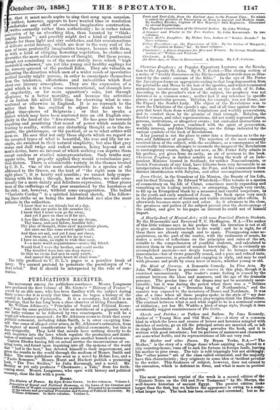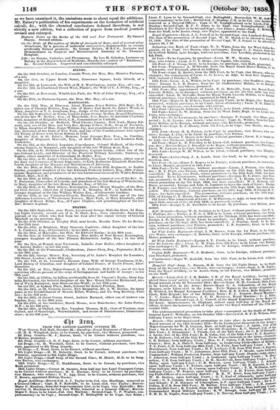PUBLICATIONS RECEIVED.
The movement among the publishers continues. Messrs. Longmans have produced the first volume of Mr. Crowe's "History of France " ; a work by an able man, who has been familiar with the subject during thirty years—for it is nearly that time since he began a history of the country in Lardner's Cycloptedia. It is a secondary, but still it is an advantage, that he has long been a close observer of living Frenchmen. Mr. William Atkinson's "Principles of Social and Political Econo- my," from the same publishers, is but an instalment of a gigantic work ; one bulky volume to be followed by two counterparts. It will be a tough job whenever mastered ; for Mr. Atkinson seems to think that every political economist, including Adam Smith, is in error excepting him- self. One cause of alleged error arises, in Mr. Atkinson's estimation from the neglect of moral considerations by political economists ; but this is done designedly. They hold that morals have nothing directly to do with inquiries into the laws which regulate the production and distri- bution of national wealth. Ethics are quite another branch of science.
Captain Rhodes having felt on actual service the inconvenience of ex- isting tents, and found upon inquiring into all the systems of the world that "bad is the best," has devoted himself to their improvement, and given the results to the world through the medium of Messrs. Smith and Elder. The same publishers also send us a novel by Holme Lee, and a ." Faerie Romance." Messrs. Hurst and Blackett publish a promising ,,,b°01; "The Two Sicilies," by Julia Kavanagh, and a novel. Mr. -mntley as yet only produces " Checkmate ; a Tale," from his forth- coming store. Messrs. Longmans, who open with history and political emicray, close the list with a poem.
Booxs.
The History of Prance. By Eyre Evans Crowe. In five volumes. Volume I. Principles of Social and Political Economy, or the Laws of the Creation and Diffusion of Wealth investigated and explained. Preceded by an examination of the extant and prevailing Principles and System of Political Economy. By Walbun Atkinson. In three volumes. Volume I. Tents and Tent-Life, from the Earliest Ages to the Present Time. To which is added the practice of Encamping an Army in Ancient and Modem thnes. By Godfrey Rhodes, Captain of Her Majesty's 94th Regiment. Illustrated by several Engravings.
The Physical Constitution of the Celestial Bodies. By John Widdup.
A Summer and Winter in the Two Sicilies. By Julia Kavannagh. In tyro volumes.
Sylvan Holl's Daughter. By Hohne Lee, Author of "Kathie Braude." In three volumes.
Fellow Travellers : or, the Experience of Life. By the Author of Margaret ; or, "Prejudice at Home," Sce. In three volumes.
Phantastcs : a Faerie Romance for Hen and Women. By George MacDonald. Author of" Within and Without."
Checkmate. A Tale.
An Hour Ago, or Time in Dreamland. A Mystery. By J. F. Corkran.
Christian Prophecy; or Popular Expository Lectures on the Revela- tion to the Apostle St. John. By S. T. Porter.—The closing section of a series of "weekly discourses on the Divine conduct towards man as illus- trated by the entire contents of the Bible." In the eye of Mr. Porter the Apocalypse forms an appropriate ending to that long dispensation from the patriarchs and Moses to the last of the apostles, and which terminated miraculous interference with human affairs on the death of St. John. According to the preacher's view of the subject, the prophecy was not historical in a common sense ; neither had it any reference to specific places, or particular persons. Babylon, for example, was not Rome, nor the Papacy the Scarlet Lady. The object of the Revelations WEIS to warn the Christians of the apostle's age, and of all time against the dan- gers that beset them from worldly temptations and worldly persecutions, and to comfort them by the promise of final triumph. Babylon, the Scarlet woman, and other representations, did not really represent places, persons, institutions, or altogether events ; but embodied abstractions so to speak. Secular power, combined with the spirit of persecution, worldly interest, and false Christianity, are the things indicated by the various symbols of the book of Revelations. A lay journal is not the place to enter into a discussion as to the na- ture and fulfilment of prophecy. The rejection of the most commonly received ideas of the subject, with the avoidance, as a consequence of the occasionally ludicrous attempts to reconcile the images of the Revelations to contemporary events, though not new, as Mr. Porter fully admits in his preface, yet gives from its rarity, an air of newness to the book. Christian Prophecy is further notable as being the work of an Inde- pendent Minister located in Scotland ; for neither Nonconformists, or Scotch Protestants of any kind, have hitherto been very favourable to an interpretation which relieves Rome, the Pope, and his communion front distinct identification with Babylon, and other uncomplimentary names.
Jeans Christ, in the Grandeur of his Mission, the Beauty of his Life, and his final Triumph. By Edward Whitefield.—This volume is a species of commentary on the life of Christ, sometimes merely expanding and remarking on its leading incidents ; or attempting, though very rarely, to fill up an Evangelical blank by a measured and careful conjecture, as in the youth and early manhood of Jesus. The book opens very much in the platform manner of iteration and visible straining after effecta. It afterwards becomes more quiet and sober. As it advances to the close, the greatness and pathos of the subject prevail over the shortcomings of the author, and give to his pages an interest he could not of himself impart.
A Handy-Boole of Musical Art; with some Practical Hints to Students. By the Honourable and Reverend T. C. Skeffington, M.A.—The author of this little volume says in his preface that his intention is not at all to give another instruction-book to the world : and he is right, for of these there are already enough and to spare. Presupposing some ac- quaintance, on the part of the reader, with the rudiments of music, he makes a series of reflections on the principles and rules of the art, suitable to the comprehension of youthful students, and calculated to interest them in the pursuit of musical knowledge. He is evidently an accomplished amateur—not deeply learned, for he betrays scientific inaccuracies—but of views generally sound, and a pure and refined taste. The book, moreover, is graceful and engaging in style, and may be read with pleasure and profit by every lover of music, whether young or ohL The Had of Norway. A Romantic Comedy. In Five Acts. By John Waddie.—There is genuine rota cornice in this play, though it re exercised unconsciously. The reader's comic feeling is roused by the contrast between the ideas and manners, and the age of the &smells personal. The precise time of the drama may not be accurately ewer-, tamable; but it was during the period when there was a " Belittle king of Britain," and a " Brennius king of Northumbria," and the country was exposed to the invasions of Danes and Northmen. It wax also at a time when all these peoples spoke in the style of " my dear fellow," with touches of what modern playwrights think the Elizabethan. The contrast between what is and what ought to be is a continual source of titillation ; yet has Mr. Waddie a kind of stage style, though it does occasionally suggest reminiscences of The Critic.
Shreds and Patches ; or Pathos and Bathos. By Jane Kennedy. Author of "Young Men and Old Men," &c,—A story of a common kind in which the loves and crosses of heroes and heroines mingled with sketches of society, go on till the principal actors are married off, or left in single blessedness. A kindly feeling pervades the book, and it is written with good intentions ; but its pictures of manners and characters are somewhat feeble, and its representations of life not very real.
The Mother and other Poems. By Bryan Yorke, B.A.—" The Mother," is the story of a village dame whose aspirins son, placed in a city counting-house, runs off to seek his fortune in foreign lands, leaving his mother to pine away. The tale is told trippingly but not strikingly. The "other poems" are of the class called occasional, and the majority have this characteristic ; they originate in some idea or incident peculiar to the writer. This freshness of subject, however, does not extend to the execution, which is deficient in force, and what is more in poetical spirit.
The most prominent reprint of the week is a second edition of the "Historic Notes on the Old and New Testament" by Mr. Sharpe, the well-known historian of ancient Egypt. The present edition looks larger than the first, but we believe the appearance is owing to a some- what larger type. The book has been revised and corrected ; but so far
as we have examined it the omissions seem to about equal the additions. Mr. Rainey's publication of his experiments on the formation of artificial &c., with the chemical conclusions deduced therefrom, is not strictly a new edition, but a collection of papers from medical journals revised and enlarged.
Historic Notes on the Books of the Old and Yew Testament. By Samuel Sharpe. Second edition.
On the Mode of Armation of Shells of Animals of Bone, and of sereral other Structures, by a process of molecular coalescence, demonstrable in certain artificially formed products. By George Rainey, M.R.C.S., Lecturer and Demonstrator on Surgical and Microscopical Anatomy at St. Thomas's Hospital.
Life : its Nature, Varieties, and Phenomena. By Leo H. Grindon, Lecturer on Botany at the Royal School of Medicine, Manchester ; author of" Emblems," 3r.c. Second Edition. Improved and considerably enlarged.



























 Previous page
Previous page